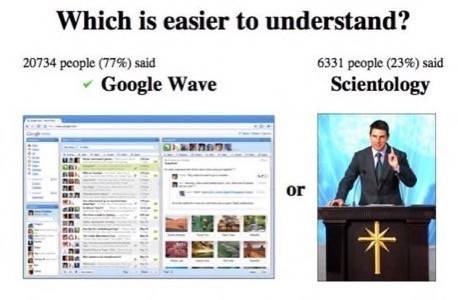Google Wave, the revolutionary product, platform and protocol for distributed, real time, app-augmented collaboration will no longer be actively developed and may be shuttered after the end of the year, Google announced this afternoon.

Why did Wave fail? Maybe because if you don’t call it an “email-killer” (and you shouldn’t) then you’d have to call it a “product, platform and protocol for distributed, real time, app-augmented collaboration.” That’s daunting and proved accessible to too few people. Still, with a rumored 100 Google engineers working on Wave to date, a call from Google for more engineering collaboration less than a month ago, and such high hopes – it’s a bit of a shock to see it come to an end.

At least it had something going for it. From the parody site EasierToUnderstandThanWave.com
When Wave launched, respected enterprise analyst Stephen O’Grady wrote a long post answering questions about the product. ” If Google Wave is successful,” he wrote, “it will mean that Google will be the vendor defining the next generation experience for millions, potentially tens of millions of users, worldwide. Next to that prospect, the threat of Google Apps is but a trifle.”
That adoption inside of companies never took off, though. Gartner may have foreshadowed some reasons why in a June, 2009 research note. A team of analysts there argued that Wave would be challenged by its “large aggregation of features, which can daunt users,” “dependence on the latest Web browser technologies,” and “likely overlap with multiple areas in an enterprise’s IT environment.”

“Wave shows that workplace offerings will eventually have to combine Internet standards and a decentralized, federated architecture,” that note continues. “Whether or not Wave ultimately succeeds, the Web will win.”
Does it still feel that way? Was Wave just too far ahead of its time?
Was it perhaps too confusing? The hour and a half long demo video Google released probably didn’t help. Gina Trapani, who cut that video up into bite sized highlights, later went on to write a collaborative manual all about using Wave.
Proponents of the service say it wasn’t that complicated and was remarkably powerful. Maybe this failure should be chalked up as another example of how Google “doesn’t get social” in terms of user experience or successful evangelism. After an immediate explosion of hype, it never felt like Google was really trying very hard with Wave.
At ReadWriteWeb, we found that Wave was very useful as a live blogging tool. So we’re sad to see it potentially go.
It will take time to figure out exactly what happened, but it’s a little shocking to hear that it’s over. It had so much potential. Clearly potential is something that’s easier to summon than it is to execute on. I hope this vision succeeds, someday.
Update: CNet’s Ina Fried caught up with Google CEO Eric Schmidt today and got some interesting quotes from him on the demise of Wave.

















